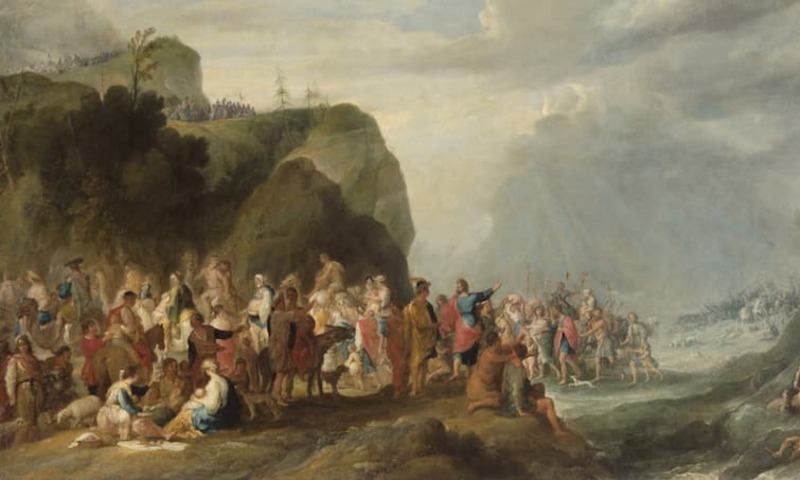The Israelites’ exodus from Egypt is a major narrative referenced throughout the Bible, and it’s known by millions around the world. But many question whether the exodus really happened, due to a presumed absence of archaeological evidence and general skepticism about the historical reliability of biblical narratives. It’s often viewed as a myth or a legendary compilation constructed from segments of different historical events spanning various periods, all merged into one edited story.
One common argument against a historical exodus is that there’s supposedly little or no evidence for such an event. However, archaeological and historical evidence points to the reliability of the biblical account of the exodus and the settlement in Canaan.
Hebrews in Egypt
The first component of this momentous story is the claim that Hebrews moved to and resided in Egypt for many generations. In a broad sense, it’s obvious from archaeological discoveries that Semites from Canaan had migrated to Egypt and settled in the northeastern Nile Delta region (Goshen), as demonstrated by specific forms of pottery, burial customs, tools and weapons, inscriptions, historical records, a Levantine breed of sheep, wall paintings, and even imported deities.
Moreover, there’s evidence of people who can be specifically identified as Hebrews residing in Egypt prior to the exodus. An Egyptian list of household slaves on Papyrus Brooklyn 35.1446, probably originating in Thebes from approximately the 17th century BC, contains the names of more than 30 Semites, who like Joseph were given new Egyptian names ().[]
These are some of the Hebrew names on this papyrus:
Hebrew Name in Papyrus Brooklyn | Occurrence in Scripture |
Shiphrah | |
‚ÄėAqoba (Jacob/Yaqob) | |
Dawidi-huat (David) | |
Esebtw (‚Äúherb‚ÄĚ) | |
Hayah-wr (Eve) | |
Menahema (Menahem) | |
Ashera (Asher) | |
Sekera (Issakar) | |
Hy’b’rw (Hebrew) |
Other names associated with Hebrews ‚ÄĒ Jacob-El (Yaqub) on scarabs from various locations and perhaps Jesse (Yushay) on an ostracon from Deir el-Bahri ‚ÄĒ have been found in Egypt from contexts before the exodus.
There was also a policy of widespread enslavement of Semites or Asiatics implemented in Egypt. This began with Ahmose I and the founding of the 18th Dynasty, around the time when ‚Äúthere arose a new king over Egypt, who did not know Joseph‚ÄĚ (). This enslavement included mudbrick production, construction projects and agriculture.[]
These accounts of Hebrew slavery appear to coincide with large storage facilities built from mudbrick during the early 18th Dynasty, found during excavations at Rameses (Tell el-Daba) and Pithom (Tell Retabeh), along with an Egyptian royal palace on the river banks that dates from around this time (1:11; 2:5‚Äď10, NIV; ).[]
Date of the Exodus and the Pharaoh
A thorough investigation of a historical exodus, however, requires knowing precisely when the exodus happened. Scripture includes clues both obvious and subtle.
First and foremost, the book of Kings records that the 480th year after the exodus was the year when Solomon began the process of building the Jerusalem temple, around 967 BC (). This aligns with Jephthah’s claim that the Israelites had been in the promised land for 300 years, approximately five decades before Saul, around 1100 BC (). We also see that 19 generations had elapsed from the exodus to the construction of the temple, which at an average of 25 years for each generation comes to about 475 years ().
Further, because information from several temple dedication inscriptions in the ancient Near East demonstrates that people counted actual solar years in this type of context, we can therefore demonstrate that the Israelites were recording real timelines.[] This helps us count back from the temple’s construction to reasonably date the exodus to roughly 1446 BC. Thus, we can look in a specific time frame for external evidence that might corroborate the Exodus account.
At that point in Egyptian history, Amenhotep II had recently become pharaoh. His predecessor, Thutmose III, had ruled for more than 40 years (see ; ). This, along with other events that fit the Exodus narrative, indicates a historical exodus would’ve occurred during his reign.
Ancient Egyptian documents, inscriptions, and archaeological findings also indicate the mysterious death of the pharaoh‚Äôs firstborn son, the military‚Äôs decline, the abandonment of his palace in the Nile Delta, the attempted erasure of Hatshepsut, and a slave raid into Canaan.[] Additionally, in the third century BC, Manetho, an Egyptian priest and historian, named an Amenhotep (Amenophis) as the pharaoh of a Hebrew exodus. Furthermore, an intriguing Egyptian poem known as ‚ÄúThe Admonitions of Ipuwer‚ÄĚ might preserve memories about the time of the Exodus plagues.[]
Amenhotep II in a chariot ©Titus Kennedy
These connections with the exodus are subject to debate. However, there‚Äôs additional archaeological evidence of Israelites outside Egypt around this time ‚ÄĒ first as nomads and then as conquerors and settlers in Canaan.
Hebrew Wandering and Appearance in Canaan
Finding archaeological evidence for nomads in ancient history is difficult because of their transience and the fragility of their material culture. Nevertheless, two Egyptian inscriptions mentioning the ‚Äúnomads of Yahweh‚ÄĚ from the Soleb temple of Amenhotep III appear to describe the wandering Israelites around 1400 BC, between the exodus and the conquest of Canaan.
These inscriptions indicate the Egyptians were familiar with the personal name of God (Yahweh) and with the Israelites, the only people in ancient times known to have worshiped Yahweh. The timing of around 40 years after the exodus, the location of these people between Egypt and Canaan, and their status as nomads support the wandering of the Israelites after leaving Egypt (; ).
Soon after, the Israelites appeared in Canaan, conquering many cities and settling in the region. Evidence related to the historicity and date of Canaan’s conquest may be communicated in some of the correspondence of various Canaanite kings with the pharaoh. These cuneiform tablets, called the Amarna Letters, mention the Habiru, a group of outsiders, who are waging war and taking cities by both force and guile.
Additionally, archaeological evidence of the destruction linked to the Israelite conquest has been cited at key cities named in the Joshua narrative, including Jericho, which shows massive fire destruction, fallen walls, no looting, and long abandonment around 1400 BC. Subsequently, settlement evidence from many towns demonstrates a new group of people had appeared in Canaan who had unique architecture, pottery, diets, and religious traditions. The Merneptah Stele of the late 13th century BC calls this people ‚ÄúIsrael,‚ÄĚ and it‚Äôs the only group of people in Canaan mentioned by the pharaoh.
These archaeological discoveries and many others support the historical reliability of the biblical narrative about the exodus and eventual settlement in Canaan. These findings can give us greater confidence in God’s word, as we appreciate his provision for his people.
The above blog ‚Äú‚ÄĚ originally published on The Gospel Coalition on November 5, 2024.
Notes
[1] William Hayes, ‚ÄúA Papyrus of the Late Middle Kingdom in the Brooklyn Museum‚ÄĚ (Brooklyn Museum, 1955).
[2] As documented in texts like these: Papyrus Leningrad 1116A; The Tomb of Rekmire; The Louvre Leather Roll.
[3] Manred Bietak and Irene Forsner-Muller, ‚ÄúThe Topography of New Kingdom Avaris and Per Ramesses,‚ÄĚ in ‚ÄúRamesside Studies in Honour of K. A. Kitchen,‚ÄĚ ed. M. Collier and S. Snape (Rutherford, 2011), 23‚Äď51; Irene Forstner-M√ľller, ‚ÄúSettlement Patterns at Avaris, A Study on Two Cases,‚ÄĚ in ‚ÄúCities and Urbanism in Ancient Egypt,‚ÄĚ ed. M. Bietak, E. Czerny, and I. Forstner-M√ľller (Austrian Academy of Sciences Press, 2006), 108‚Äď24; Manfred Bietak, ‚ÄúPeru-nefer: The Principal New Kingdom Naval Base,‚ÄĚ ‚ÄúEgyptian Archaeology‚ÄĚ 34 (2009): 15‚Äď17; Bryant Wood, ‚ÄúNew Discoveries at Rameses,‚ÄĚ ‚ÄúBible and Spade‚ÄĚ 21, no. 1 (2008): 28‚Äď32; SŇāawomir Rzepka, et al., ‚ÄúEgyptian Mission Rescue Excavations in Tell el-Retaba. Part 1: New Kingdom Remains,‚ÄĚ ‚ÄúEgypt and the Levant‚ÄĚ 22/23 (2012/2013): 253‚Äď87.
[4] Titus Kennedy, ‚ÄúTemple Dedication and Construction Texts of the Ancient Near East with Elapsed Years: Implications for Long Duration Chronologies,‚ÄĚ ‚ÄúReligions‚ÄĚ 15, no. 4 (2024): 408, .
[5] Douglas Petrovich, ‚ÄúAmenhotep II and the Historicity of the Exodus-Pharaoh,‚ÄĚ ‚ÄúThe Master's Seminary Journal‚ÄĚ 17, no. 1 (2006); David Hansen, ‚ÄúMoses and Hatshepsut,‚ÄĚ ‚ÄúBible and Spade‚ÄĚ 16 no. 1 (2003); Titus Kennedy, ‚ÄúThe Essential Archaeological Guide to Bible Lands‚ÄĚ (Harvest House, 2023); David Hansen, ‚ÄúMoses and Hatshepsut,‚ÄĚ ‚ÄúBible and Spade‚ÄĚ 16 no. 1 (2003):14‚Äď20.
[6] Titus Kennedy, ‚ÄúIpuwer Versus the Exodus Plagues,‚ÄĚ ‚ÄúBible and Spade‚ÄĚ 35:1 (2022): 23‚Äď32.
[7] Titus Kennedy, ‚ÄúThe Land of the SAsw (Nomads) of yhwA at Soleb,‚ÄĚ ‚ÄúDotawo: A Journal of Nubian Studies‚ÄĚ 6 (2019): 175‚Äď192, .
[8] William Moran, ‚ÄúThe Amarna Letters‚ÄĚ (Johns Hopkins University Press, 2002), letters EA 286, EA 727, EA 288, and EA 289.
[9] Titus Kennedy, ‚ÄúThe Bronze Age Destruction of Jericho: Archaeology, and the Book of Joshua,‚ÄĚ ‚ÄúReligions‚ÄĚ 14, no. 6: 796, .
[10] Michael Hasel, ‚ÄúIsrael in the Merneptah Stela,‚ÄĚ ‚ÄúBulletin of the American Schools of Oriental Research‚ÄĚ 296 (1994): 45‚Äď61
 ļŕ›ģ ”∆Ķ
ļŕ›ģ ”∆Ķ

.jpg)


